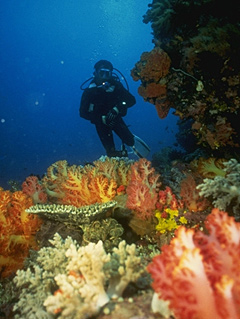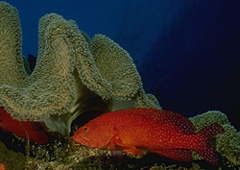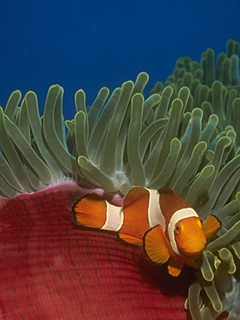|
|
Coral reefs are some of the most biologically rich and economically valuable ecosystems on Earth. They provide food, jobs, income, protection, and other important services to billions of people worldwide. Yet they are threatened by an increasing array of impacts from overexploitation, pollution, habitat loss, invasive species, diseases, bleaching, and global climate change. The rapid decline and loss of these valuable, ancient, and complex marine ecosystems have significant social, economic, and environmental consequences in the United States and around the world. As a principal steward of the nation's marine resources, NOAA helps coastal communities, managers, scientists, and other partners to understand and sustainably manage coral reef ecosystems.
In 2000, the U.S. Coral Reef Task Force (Task Force) developed the National Action Plan to Conserve Coral Reefs (pdf, 211 kb) to serve as the nation's blueprint for reversing the decline of coral reef ecosystems in U.S. waters. As co-chair of the Task Force, and as directed by the Coral Reef Conservation Act of 2000 (pdf, 36 kb), NOAA has the responsibility to conserve coral reef ecosystems. In September 2002, in cooperation with The Task Force, NOAA released a report to Congress entitled A National Coral Reef Action Strategy (pdf, 2 Mb), which provides a nationwide status report on implementation of the National Action Plan to Conserve Coral Reefs and the Coral Reef Conservation Act of 2000. In July of 2005, this report was followed by an additional report to Congress entitled Implementation of the National Coral Reef Action Strategy. This report provides a nationwide status update on implementation of the National Action Plan to Conserve Coral Reefs and the Coral Reef Conservation Act of 2000. The next report to Congress will be released in November of 2007.
NOAA’s coral reef conservation efforts are carried out primarily through its Coral Reef Conservation Program (CRCP). The program brings together the expertise of NOAA's National Ocean Service (NOS), NOAA Fisheries, NOAA Research, and NOAA Satellites and Information. Under this program, NOAA works with scientific, private, government, and nongovernmental organizations at the local, federal, and international levels to address conservation actions laid out in the National Action Plan to Conserve Coral Reefs. From 2002 to 2006, NOAA has supported over $27.6 million in matching grants through this program. Approximately $6.5 million was appropriated for the fiscal year 2007 awards, and the same amount is anticipated for fiscal year 2008 grants (pending appropriations). NOS and its partners carry out numerous activities related to coral reefs. NOS's Office of Ocean and Coastal Resource Management (OCRM) serves as the headquarters for NOAA's CRCP, coordinating collaborative planning, implementation, evaluation, and reporting for the program. OCRM also coordinates two NOAA grant programs that support external coral reef conservation activities. NOAA’s Coral Reef Conservation Grants Program supports research, management, and monitoring of coral reef ecosystems both domestically and internationally. The Coral Reef Conservation Fund, a partnership between the National Fish and Wildlife Foundation and NOAA, supports public-private partnerships to conserve coral reefs.
Additional NOS offices that participate in the CRCP include the Office for International Programs, the Coastal Services Center, Special Projects, the Office of Response and Restoration, the National Centers for Coastal Ocean Science, and the Office of Coast Survey. The CRCP also collaborates with the Office of National Marine Sanctuaries and the Center for Operational Oceanographic Products and Services. More information on NOAA's coral reef activities, and the role of each participating office, can be found on NOAA's Coral Reef Information System. Visit NOAA's CRCP for current news and highlights of NOAA’s coral reef activities.
(top)
|
Educational ResourcesCoral Reef Conservation Lesson Plans Coral Reef Conservation Program Education Resources
|
|||||||||||||||||||||||
- NOS Program Offices
- Center for Operational Oceanographic Products and Services
- National Centers for Coastal Ocean Science
- NOAA Coastal Services Center
- National Geodetic Survey
- Office of Coast Survey
- Office of National Marine Sanctuaries
- Office of Ocean and Coastal Resource Management
- Office of Response and Restoration

Revised August 18, 2008
| Questions, Comments? Contact Us | Report
Error | Disclaimer | About
the Site | User Survey
National Oceanic and Atmospheric
Administration | U.S.
Department of Commerce | USA.gov
http://oceanservice.noaa.gov/topics/oceans/coralreefs/welcome.html



